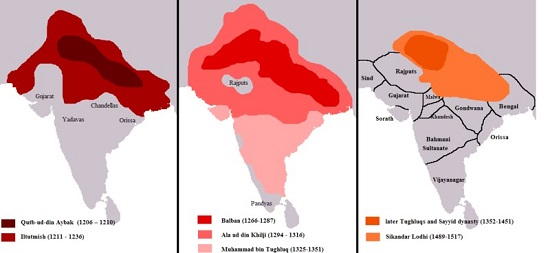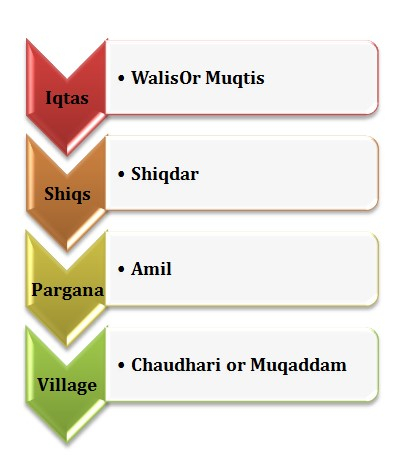

The Sultanate of Delhi began with the Slave dynasty and was founded by Qutub-ud-din Aibak. He was the slave of Mohammad Ghori and this dynasty was also familiar as the Mamluk dynasty. There were also four more dynasties that came after this dynasty that was; the Khilji dynasty, Tughlaq dynasty, Sayyid dynasty and Lodhi dynasty. The end of this Sultanate happened in the Lodhi dynasty in the year 1526

The Delhi Sultanate was the period of time when many Muslim dynasties were governed in India. This Sultanate was established by Mohamed Ghori in 1192 in Delhi after defeating Prithviraj Chauhan (ancient-origins, 2022). The uprising of the Delhi Sultanate began from 1206 CE to 1526 CE and during that time five dynasties governed Delhi. The Delhi Sultanate’s administration was established on the laws of Muslims and that was also familiar as Islamic law or Shariat. The Sultans and the court’s nobles were responsible for observing whether the Sariat’s laws were obeyed in every state matter.
A huge impact was generated by the Delhi Sultanate administration system on the provincial kingdoms of India. The Sultan title was first taken by the Turkish ruler Mahmud. The main religion of this state was Islam and the state was familiar as the Islamic state.
It was thought that the Caliph was represented by the Sultans and it was also written on the Delhi Sultanates coins and practice was started by Balban, the shadow of God. Sultan was the chief authority of the political, legal and military activities. The unambiguous succession law did not exist at that time, therefore, every son of the Sultan had an equal right to the throne but if any Sultan nominated a specific child as his successor then the nobles had to be approved that.
There were various officials and departments that helped Sultan to administrate the state. The post of Naib was very powerful and the person could enjoy every power of the Sultan and had the authority over every department. Wazir was the next powerful post after Naib and controlled the department of finance that is familiar as Diwan-i-Wizarat . An Accountant General and an Auditor-General worked beneath the Wazir for examining income and checking expenditure.
The department of the military was known as Diwan-i- Ariz and Ariz-i-Mumalik commanded this department. He was also responsible for the recruitment of administrators of the military department and the soldiers. The army’s Commander-in-chief was the Sultan.
The religious affairs department, Diwan-i-Risalat managed the religious institution and accept the stipends of the men and scholars of piety. The funds for the madrasas, mosques and tombs’ construction were granted by this department. Chief Sadr had the authority of this department and he was also the Chief Qazi, judicial system’s head. The civil matters followed the personal law of Muslims or Sharia. The Hindus had their own law and the panchayat of the village dispensed their cases. The criminals were punished by the regulations and rules that were approved by Sultans. The correspondence department was known as Diwan-i-Insha and they control every correspondence between the other states’ sovereigns and the ruler.

The provinces of the Delhi Sultanate were controlled by the nobles from the beginning and this was known as Iqtas. The provinces’ governors were entitled to Walis or Muqtis and they maintained the law and collected the revenue of the land . The provinces were split into Shiqs and they were controlled by the Shiqdar. The division of Shiqs was familiar as Pargana that was the combination of some villages. Pargana was controlled by Amil. The administration’s basic unit was the villages and the headman of those villages was familiar as Muqaddam or Chaudhri and the village accountant was Patwari.
The Sultanate of Delhi categorised the lands into three groups that are,
Iqta land − These types of lands were given as iqtas to the officials as an alternative remission for their assistance.
Khalisa land − Sultan controlled these types of lands and the revenue from these lands was used for the royal household and royal court maintenance.
Inam land − These lands were given to the Religious leaders or the religious institute
The farmers had to pay one-third to half of the production as the revenue of the land and also paid the various taxes that made their life miserable. Muhammad Bin Tughlaq and Firoz Tughlaq started many irrigation solutions and begins Takkavi loans that aided the increment in the production of agriculture. Muhammad Bin Tughlaq also established a separate department of agriculture, Diwan-i-Koh.
The Sultanate of Delhi was one of the biggest Sultanates in Indian history that was governed by five different dynasties. The administration of these sultanates was created based on the Sariat. The architecture and art flourished at that time and some of their work is still seen in Qutub Minar, Lodi Gardens, Alai Darwaz and many more. The cotton and silk textile thrived in the time of Delhi Sultanate. Many roads were constructed during that time to smooth the transportation facilities.
Q. Who were the most important three rules of the Slave Dynasty?
Qutb-ud-din Aibak (1206-1210), Iltutmish (1210-1236) and Balban was three of the most important rulers of the Slave dynasty. The founder of this dynasty was Qutb-ud-din Aibak and during his time the capital was situated in Lahore.
Q. Who built the Qutub Minar?
Qutub-ud-din Aibak constructed the Qutub Minar and Iltutmish completed this. This minar was built as a remembrance of the Sufi saint Qutub-ud-din Bakhtiyar Kaki. The entrance of Qutub Minar, Alai Darwaza was manufactured by Alauddin Khalji built.
Q. What are the two revenue administrations during Delhi Sultanates?
The administration of revenue was categorised into groups, that were, Judicial and Military Administration. Sultan had the highest authority of the judicial administration. The army was divided into Royal Army, Governor’s army, Feudal army and War-Time army.